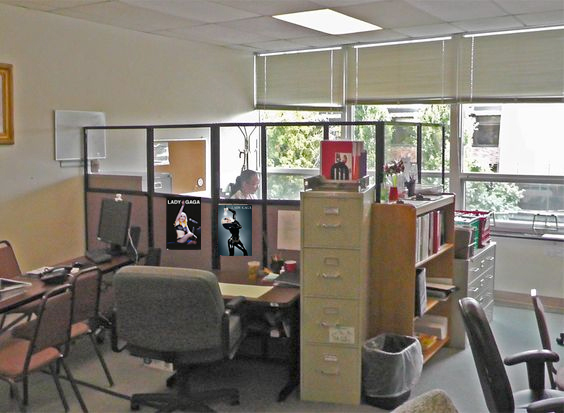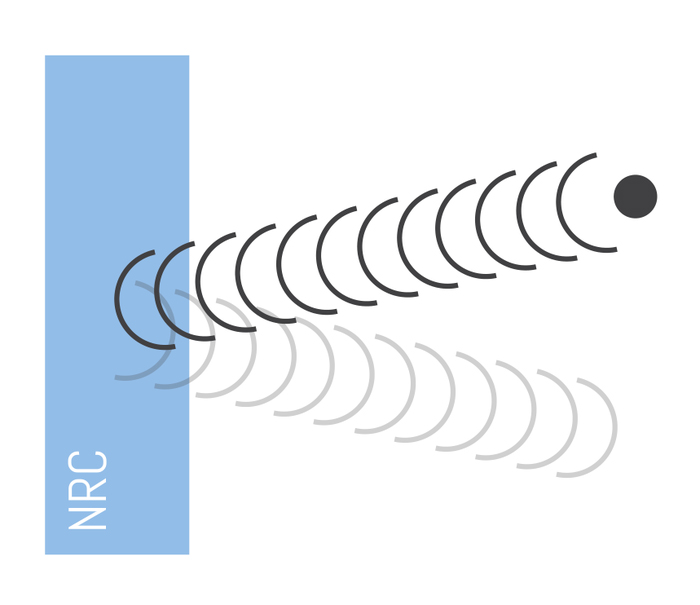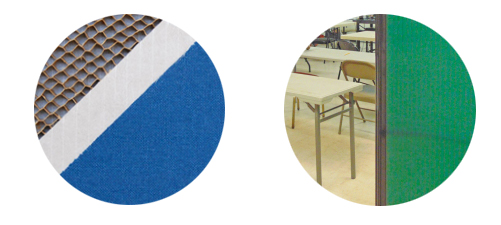Breaking Waves: Sound-Dampening Partitions Demystified
Mar 5th 2016
In addition to creating visual privacy, our sound-dampening partitions offer enhanced acoustic control. There are ways of measuring the acoustical control of a partition, but it can be innitially difficult to understand. Acronyms like NRC and STC may have you thinking things like WTF, but relax - we've created a quick guide to help you better understand acoustics and how our sound-dampening partitions work. It’s time to break down some barriers (metaphorically speaking, of course) and explain what those letters mean, along with the difference between sound blocking and sound absorption.
Sound Transmission Class (STC)
Sound Transmission Class, or STC, measures how much sound a partition blocks. Unlike your cholesterol or putt putt score, a higher number is usually better when it comes to STC. Sound Transmission Class gives a general idea of how much sound a partition can stop, and it’s the most common sound reduction measurement. However, it cannot be completely relied upon because the human ear responds more to certain frequencies than others.
[caption id="attachment_735" align="aligncenter" width="564"] Dampen sound frequencies like your coworker's humming of Lady Gaga tunes[/caption]
Noise Reduction Coefficient (NRC)
Noise Reduction Coefficient, or NRC, measures how much sound a partition absorbs. NRC is used to gauge partitions that are created to absorb (not block) sound. The NRC rating for sound absorbing partitions ranges from 0 (perfectly reflective) to 1 (perfectly absorptive). Think of NRC as the percentage of sound waves that come into contact with the partition without being reflected back (Ex: NRC of .2=20%). NRC ratings depend on a number of variables, like wall conditions and ceiling height.
Dampen sound frequencies like your coworker's humming of Lady Gaga tunes[/caption]
Noise Reduction Coefficient (NRC)
Noise Reduction Coefficient, or NRC, measures how much sound a partition absorbs. NRC is used to gauge partitions that are created to absorb (not block) sound. The NRC rating for sound absorbing partitions ranges from 0 (perfectly reflective) to 1 (perfectly absorptive). Think of NRC as the percentage of sound waves that come into contact with the partition without being reflected back (Ex: NRC of .2=20%). NRC ratings depend on a number of variables, like wall conditions and ceiling height.
 NRC vs. STC
You’ve probably gathered by now that the main difference between NRC and STC is that STC gauges materials that block sound, while NRC gauges materials that absorb sound. Versare’s dynamic line of portable partitions includes materials that absorb and block sound. Partitions with dense cores—such as our polycarbonate cores—block sound (high STC rating), while those with lower density cores—like our honeycomb/fiberglass combinations—absorb sound (high NRC rating).
[caption id="attachment_739" align="aligncenter" width="501"]
NRC vs. STC
You’ve probably gathered by now that the main difference between NRC and STC is that STC gauges materials that block sound, while NRC gauges materials that absorb sound. Versare’s dynamic line of portable partitions includes materials that absorb and block sound. Partitions with dense cores—such as our polycarbonate cores—block sound (high STC rating), while those with lower density cores—like our honeycomb/fiberglass combinations—absorb sound (high NRC rating).
[caption id="attachment_739" align="aligncenter" width="501"] Acoustical fabric vs reflective polycarbonate[/caption]
Still feeling overwhelmed? Our team of experts can help you choose the right sound-dampening system to suit your needs. Whether you’re forming makeshift classrooms for an adult learning center, building a (quiet from the outside) Vacation Bible School play land, or providing some much-needed peace to employees, we have you covered.
Acoustical fabric vs reflective polycarbonate[/caption]
Still feeling overwhelmed? Our team of experts can help you choose the right sound-dampening system to suit your needs. Whether you’re forming makeshift classrooms for an adult learning center, building a (quiet from the outside) Vacation Bible School play land, or providing some much-needed peace to employees, we have you covered.
 Dampen sound frequencies like your coworker's humming of Lady Gaga tunes[/caption]
Noise Reduction Coefficient (NRC)
Noise Reduction Coefficient, or NRC, measures how much sound a partition absorbs. NRC is used to gauge partitions that are created to absorb (not block) sound. The NRC rating for sound absorbing partitions ranges from 0 (perfectly reflective) to 1 (perfectly absorptive). Think of NRC as the percentage of sound waves that come into contact with the partition without being reflected back (Ex: NRC of .2=20%). NRC ratings depend on a number of variables, like wall conditions and ceiling height.
Dampen sound frequencies like your coworker's humming of Lady Gaga tunes[/caption]
Noise Reduction Coefficient (NRC)
Noise Reduction Coefficient, or NRC, measures how much sound a partition absorbs. NRC is used to gauge partitions that are created to absorb (not block) sound. The NRC rating for sound absorbing partitions ranges from 0 (perfectly reflective) to 1 (perfectly absorptive). Think of NRC as the percentage of sound waves that come into contact with the partition without being reflected back (Ex: NRC of .2=20%). NRC ratings depend on a number of variables, like wall conditions and ceiling height.
 NRC vs. STC
You’ve probably gathered by now that the main difference between NRC and STC is that STC gauges materials that block sound, while NRC gauges materials that absorb sound. Versare’s dynamic line of portable partitions includes materials that absorb and block sound. Partitions with dense cores—such as our polycarbonate cores—block sound (high STC rating), while those with lower density cores—like our honeycomb/fiberglass combinations—absorb sound (high NRC rating).
[caption id="attachment_739" align="aligncenter" width="501"]
NRC vs. STC
You’ve probably gathered by now that the main difference between NRC and STC is that STC gauges materials that block sound, while NRC gauges materials that absorb sound. Versare’s dynamic line of portable partitions includes materials that absorb and block sound. Partitions with dense cores—such as our polycarbonate cores—block sound (high STC rating), while those with lower density cores—like our honeycomb/fiberglass combinations—absorb sound (high NRC rating).
[caption id="attachment_739" align="aligncenter" width="501"] Acoustical fabric vs reflective polycarbonate[/caption]
Still feeling overwhelmed? Our team of experts can help you choose the right sound-dampening system to suit your needs. Whether you’re forming makeshift classrooms for an adult learning center, building a (quiet from the outside) Vacation Bible School play land, or providing some much-needed peace to employees, we have you covered.
Acoustical fabric vs reflective polycarbonate[/caption]
Still feeling overwhelmed? Our team of experts can help you choose the right sound-dampening system to suit your needs. Whether you’re forming makeshift classrooms for an adult learning center, building a (quiet from the outside) Vacation Bible School play land, or providing some much-needed peace to employees, we have you covered.


